-
 Shibuichi Kozuka carved in low relief (takabori, usuniku-bori) and inlaid in gold and silver with design of Shoko, reading by moonlight, thatch, pine rosettes, and fool moon. According to Henri L. Joly [LEGEND IN JAPANESE ART. London, 1908; LIB-1416 in this collection] Shoko was a Chinese student of Taoism who was so poor that he had no money to buy illuminating materials and read by moonlight. Shoko mentioned in the article about another Chinese character - Shaen, who was reading by the light emitted by glow-worms (see page 310). Signed on the back: Haruchika (春親) + kaō. Size: 97.3 mm (H) x 14.8 mm (W). Edo period, mid 19th century. NBTHK Certificate № 449542. Hamano Haruchika from Edo was a student of Haruyuki in 1848-54; Hamano School, Etchū Toyama Branch, according to M. Sesko's "Genealogy", page. 34. Most probably it is his work. Following the MFA data, it is also possible that "our" Haruchika is indeed Nara Haruchika or Tsuchiya Haruchika from Nara School; though I did not hind such artist in Markus Sesko books. However, in his "Toso-Kinko" on page 177 there is certain Shingorō who carried out his business under the name of Yanagawa Haruchika (1791-1857?)
Shibuichi Kozuka carved in low relief (takabori, usuniku-bori) and inlaid in gold and silver with design of Shoko, reading by moonlight, thatch, pine rosettes, and fool moon. According to Henri L. Joly [LEGEND IN JAPANESE ART. London, 1908; LIB-1416 in this collection] Shoko was a Chinese student of Taoism who was so poor that he had no money to buy illuminating materials and read by moonlight. Shoko mentioned in the article about another Chinese character - Shaen, who was reading by the light emitted by glow-worms (see page 310). Signed on the back: Haruchika (春親) + kaō. Size: 97.3 mm (H) x 14.8 mm (W). Edo period, mid 19th century. NBTHK Certificate № 449542. Hamano Haruchika from Edo was a student of Haruyuki in 1848-54; Hamano School, Etchū Toyama Branch, according to M. Sesko's "Genealogy", page. 34. Most probably it is his work. Following the MFA data, it is also possible that "our" Haruchika is indeed Nara Haruchika or Tsuchiya Haruchika from Nara School; though I did not hind such artist in Markus Sesko books. However, in his "Toso-Kinko" on page 177 there is certain Shingorō who carried out his business under the name of Yanagawa Haruchika (1791-1857?) -

Iron tsuba of circular form with design of pine trees (matsu) and monkey toys (kukurizaru) in openwork (ko-sukashi). Ko-Katchushi school.
Raised rim (mimi) with iron bones (tekkotsu). Size: Diameter: 99.5 mm; Thickness: 2.1 mm at centre; 4.3 mm at the rim.Early Muromachi period: 15th century (Kakitsu - Bun'an era, 1441 - 1449).
-
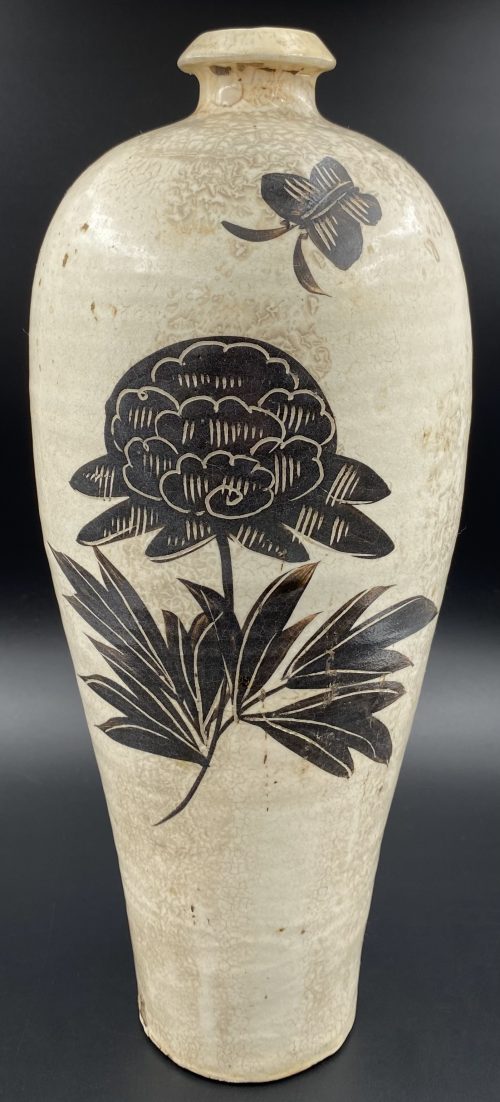 Typical meiping body, short neck, lipped rim; painted in the blackish-brown slip with two blossoms and butterflies under a clear glaze. The foot ring is unglazed exposing the brown body. China, the Yuan Dynasty [大元] (1279 – 1368). Diameter: 14 cm; Height: 30.5 cm.
Typical meiping body, short neck, lipped rim; painted in the blackish-brown slip with two blossoms and butterflies under a clear glaze. The foot ring is unglazed exposing the brown body. China, the Yuan Dynasty [大元] (1279 – 1368). Diameter: 14 cm; Height: 30.5 cm. -
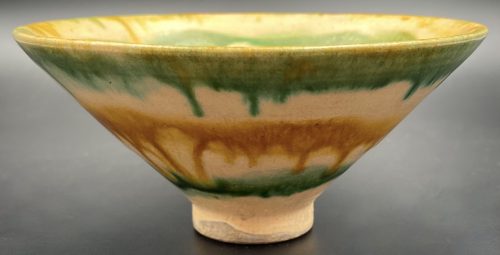 Footed conical bowl decorated with green and amber bleeding concentric circles on cream background inside and outside. Diameter: 13.5 cm, H: 6.2 cm;
Footed conical bowl decorated with green and amber bleeding concentric circles on cream background inside and outside. Diameter: 13.5 cm, H: 6.2 cm; -
 Iron tsuba of round form decorated with eight roundels – circular emblems of flowers and/or family crests (mon) made of cast brass, pierced and chiselled in kebori, and with flat brass inlay (hira-zōgan) of vines or leaves all over the plate. Both hitsu-ana are trimmed with brass. Nakago-ana of trapezoidal form. A distinctive character of this tsuba is a mon at 12 hours, depicting paulownia, or Kiri-mon [桐紋] – a symbol of the Toyotomi clan, led by Toyotomi Hideyoshi (豊臣 秀吉, 1537 – 1598). Kiri-mon was also used as fuku-mon (alternative family crests) for the Imperial Family and Imperial Court. Another important emblem at 6 o’clock is the Katakura clan [片倉氏, Katakura-shi] family crest. Katakura Kagetsuna (片倉 景綱, 1557 – 1615), a retainer of Date Masamune (伊達 政宗, 1567 – 1636); Kagetsuna was operational in Hideyoshi’s Odawara campaign in 1590, which ultimately ended the unification of Japan. Unsigned but may be attributed to Koike Yoshirō Naomasa or his workshop (Yoshirō, orKaga-Yoshirō school). Dimensions: Diameter: 85.5 mm; Thickness at seppa-dai: 5.0 mm.
Iron tsuba of round form decorated with eight roundels – circular emblems of flowers and/or family crests (mon) made of cast brass, pierced and chiselled in kebori, and with flat brass inlay (hira-zōgan) of vines or leaves all over the plate. Both hitsu-ana are trimmed with brass. Nakago-ana of trapezoidal form. A distinctive character of this tsuba is a mon at 12 hours, depicting paulownia, or Kiri-mon [桐紋] – a symbol of the Toyotomi clan, led by Toyotomi Hideyoshi (豊臣 秀吉, 1537 – 1598). Kiri-mon was also used as fuku-mon (alternative family crests) for the Imperial Family and Imperial Court. Another important emblem at 6 o’clock is the Katakura clan [片倉氏, Katakura-shi] family crest. Katakura Kagetsuna (片倉 景綱, 1557 – 1615), a retainer of Date Masamune (伊達 政宗, 1567 – 1636); Kagetsuna was operational in Hideyoshi’s Odawara campaign in 1590, which ultimately ended the unification of Japan. Unsigned but may be attributed to Koike Yoshirō Naomasa or his workshop (Yoshirō, orKaga-Yoshirō school). Dimensions: Diameter: 85.5 mm; Thickness at seppa-dai: 5.0 mm.
Kiri-mon

Katakura-mon
-
 Iron tsuba of round form profusely decorated with brass inlay of plants, birds, well, and family crests (mon) in suemon-zōgan technique and occasional brass dots (nail-heads) or ten-zōgan. Seppa-dai and kozuka-hitsu-ana outlined with brass inaly, possibly repaired: rope-shaped wire here and there replaced with flat wire. The plate is very thin, with remnants of lacquer. Ōnin school. Size: 75.8 x 75.2 x 2.3 mm. Weight: 77.5 g. On the front side (omote) motif includes the following elements (from 12 o'clock, clockwise):
Iron tsuba of round form profusely decorated with brass inlay of plants, birds, well, and family crests (mon) in suemon-zōgan technique and occasional brass dots (nail-heads) or ten-zōgan. Seppa-dai and kozuka-hitsu-ana outlined with brass inaly, possibly repaired: rope-shaped wire here and there replaced with flat wire. The plate is very thin, with remnants of lacquer. Ōnin school. Size: 75.8 x 75.2 x 2.3 mm. Weight: 77.5 g. On the front side (omote) motif includes the following elements (from 12 o'clock, clockwise):- Water plantain (a.k.a. arrowhead, or omodaka): "a perpetual plant of the water plantain family, was also called shōgunsō (victorious army grass). Because of this martial connotation, it was a design favored for the crests of samurai families" [see: Family Crests of Japan. // Stone Bridge Press, Berkeley, CA, 2007; p. 63].
- Heron (sagi): "...considered an emblem of longevity, and from China comes the practice of regarding the bird as a mount of the gods and the Taoist sennin. [...] heron also reflects an inauspicious connotation, for the word sagi is homophone for 'fraud' and 'false pretenses'." [see: Merrily Baird. Symbols of Japan. Thematic motifs in art and design. // Rizzoli international publications, Inc., 2001; p. 112]. Some may say, that this is not a heron but a crane (tsuru). It's very possible, and in this case the negative connotation is lost, but the reference to longevity and allusion to sennin remain.
- Pampas grass (susuki, or obana): as per Merrily Baird, p. 95 and John W. Dower, p. 66, pampas grass is one of the Seven Grasses of Autumn. When combined with flying wild gees, conveys strong autumnal mood.
- Plum blossom (ume): according to Merrily Baird, the flower has a vast variety of symbolic meanings, including longevity, and a reference to the Chinese Taoists. It is used in 80 family crests [see: Japanese Design Motifs: 4,260 Illustrations of Japanese Crests; Compiled by the Matsuya Piece-Goods Store; Translated by Fumie Adachi. // Dover Publications, Inc., 1972.] Plum is "celebrated for its sweet perfume, delicate blossoms, and habit of blooming at the end of winter".
- Tree flying wild geese (kari): "Wild geese arrive in large flocks in southern regions during the autumn months, and following their migratory instincts, head back north in spring" [Family Crests of Japan, pp. 85-86]. "The importance of geese in Japanese art was further secured by stories of several military heroes who had achieved victory in battle when a sudden breaking of ranks by flying geese signaled an ambush. The protective role of the birds led to their frequent use in decorating sword furnishings and possibly also their adoption as a family crest motif.Finally, the goose in Asia plays a role in religious traditions" [Merrily Baird, pp.111-112].
- Hikiryō (line, or bar, or stripe) - a symbol which consists of one, two, or three horizontal or vertical stripes in a circle. "In wartime, Japanese generals [...] surrounded their encampments with huge cloth curtains. Usually these were made of cloth sewn together horizontally and varying in color [...] to distinguish the individual general and his followers. The stripe thus assumed strong martial connotations, and became a mark of identification on personal military gear as well. In the early fourteenth century the heads of the Ashikaga and Nitta, then the two most powerful clans in Japan, both adopted stripe patterns as a family crest". [See: Family Crests of Japan, p. 111 and John W. Dower. The elements of Japanese design - A handbook of family crests, heraldry & symbolism. // Weatherhill, New York, Tokyo, 1985, p. 144].
- Hikiryō, see above.
- Pampas grass (susuki, or obana), see above.
- Bellflower (kikyo): One of the Seven Grasses of Autumn. "As a crest, it have been adopted among the warriors around the thirteenth century, primarily because of it's beauty" [John W. Dower, p. 48].
- Four flying wild geese (kari), see above.
- Weeping willow (yanagi): "It is commonly represented with water, snow, swallows, or herons. A branch of willow (yoshi) is one of the attributes of the Buddhist deity Senju Kannon (Thousand-Armed Kannon), who is said to use the branch to sprinkle the nectar of life contained in a vase. [Merrily Baird, pp. 66-67].
- Lone plum blossom in a well frame/crib (igeta, izitsu): "Well crib was one of the most popular motifs in Japanese heraldry". As a crest it may stay simply for the first character (i) of the family name, however, with a flower inside the well frame, and together with the other symbols present, it may aggravate the sense of autumn-ness. The ten-zōgan dots in this particular case may represent the snowflakes or autumn stars.
-
 Iron tsuba of round form with design of butterfly (left) and dragonfly (right) in openwork (sukashi), outlined with brass wire. Thin plate also decorated with five concentric circular rows of brass dots (nail heads) in ten-zōgan; brass wire outlines of the center of the plate. School: Ōnin ten-zogan. Late Muromachi period, 16th century. Diameter: 88 mm, thickness at seppa-dai: 3.1 mm. Another tsuba of similar design, Tōshō school, is illustrated in this collection; see TSU-0353.Reference to the design has been found at "Japanese Swords and Tsuba from the Professor A. Z. Freeman and the Phyllis Sharpe Memorial collections". Sotheby's, London, Thursday 10 April 1997; p. 18, item 37: "pierced with two large formalised butterflies...".
Iron tsuba of round form with design of butterfly (left) and dragonfly (right) in openwork (sukashi), outlined with brass wire. Thin plate also decorated with five concentric circular rows of brass dots (nail heads) in ten-zōgan; brass wire outlines of the center of the plate. School: Ōnin ten-zogan. Late Muromachi period, 16th century. Diameter: 88 mm, thickness at seppa-dai: 3.1 mm. Another tsuba of similar design, Tōshō school, is illustrated in this collection; see TSU-0353.Reference to the design has been found at "Japanese Swords and Tsuba from the Professor A. Z. Freeman and the Phyllis Sharpe Memorial collections". Sotheby's, London, Thursday 10 April 1997; p. 18, item 37: "pierced with two large formalised butterflies...".
TSU-0353: Tōshō tsuba, Muromachi period.

A kamakura-bori tsuba. Momoyama period. Freeman & Sharpe Memorial Collections.
-
 Iron tsuba of round form with circular iron wire fastened to the surface with iron and brass staples (mukade-zōgan); brass ring about 2.5 mm wide along the rim with chisel marks. Design repeats on the reverse. Copper sekigane. Early Edo, 17th century. Size: Height: 83.3 mm; width 83.9 mm; thickness at seppa-dai: 4.5 mm. Weight 173.6 g. Design is thought to resemble a centipede. "Centipede-like inlay (mukade zogan) of alternating iron and brass staples produce an appearance that was particularly favored by Takeda Shingen (1521-1573), one of the most powerful warlords of his time. The centipede is sacred to Bishamon (God of War) and especially propitious for a warrior. Shingen type, 16th century.” [The Peabody Museum collection of Japanese sword guards with selected pieces of sword furniture, by John D. Hamilton. Photographs by Mark Sexton. Salem, MA, 1975.] See also: http://varshavskycollection.com/shingen-tsuba/ SOLD
Iron tsuba of round form with circular iron wire fastened to the surface with iron and brass staples (mukade-zōgan); brass ring about 2.5 mm wide along the rim with chisel marks. Design repeats on the reverse. Copper sekigane. Early Edo, 17th century. Size: Height: 83.3 mm; width 83.9 mm; thickness at seppa-dai: 4.5 mm. Weight 173.6 g. Design is thought to resemble a centipede. "Centipede-like inlay (mukade zogan) of alternating iron and brass staples produce an appearance that was particularly favored by Takeda Shingen (1521-1573), one of the most powerful warlords of his time. The centipede is sacred to Bishamon (God of War) and especially propitious for a warrior. Shingen type, 16th century.” [The Peabody Museum collection of Japanese sword guards with selected pieces of sword furniture, by John D. Hamilton. Photographs by Mark Sexton. Salem, MA, 1975.] See also: http://varshavskycollection.com/shingen-tsuba/ SOLD -
 Tsuba of chrysanthemoid form (kikka-gata) with yamagane core and woven copper wire pattern. Copper sekigane. Shingen school. Height: 70.2 mm; Width 67.2 mm; Thickness at seppa-dai: 3.4-3.6 mm, overall 7.3 mm. Weight 82.7 g Inscription on the wooden box reads: "Muromachi period Mumei Zōgan Shingen Tsuba" Muromachi period, 16th century. Age attribution is based on the fact that the core is made of yamagane; later copies of Edo period are usually made of iron. This small and light tsuba was likely mounted on a combat sword, while larger and much heavier woven wire Shingen tsuba of Edo period were of purely decorative purpose. http://varshavskycollection.com/shingen-tsuba/
Tsuba of chrysanthemoid form (kikka-gata) with yamagane core and woven copper wire pattern. Copper sekigane. Shingen school. Height: 70.2 mm; Width 67.2 mm; Thickness at seppa-dai: 3.4-3.6 mm, overall 7.3 mm. Weight 82.7 g Inscription on the wooden box reads: "Muromachi period Mumei Zōgan Shingen Tsuba" Muromachi period, 16th century. Age attribution is based on the fact that the core is made of yamagane; later copies of Edo period are usually made of iron. This small and light tsuba was likely mounted on a combat sword, while larger and much heavier woven wire Shingen tsuba of Edo period were of purely decorative purpose. http://varshavskycollection.com/shingen-tsuba/ -
 Iron tsuba of otafuku-gata form decorated on the face with death and autumn motifs: autumnal grasses and flowers in yellow brass and shakudō, skull, limb bone and sternum inlaid in shakudō. On the reverse the plate is inlaid in red copper with a chrysanthemum and maple leaves floating in stylized water streams. "Plants floating atop water form common motifs, as occurs with chrysanthemums, maple leaves, and cherry blossoms, in particular." [Merrily Baird]. Such plants may be used as a family crest (mon), or may be just a reminder of a floating nature of life. Momoyama period, late 15th century. Dimensions: 75.3 x 69.9 x 4.3 mm.
Iron tsuba of otafuku-gata form decorated on the face with death and autumn motifs: autumnal grasses and flowers in yellow brass and shakudō, skull, limb bone and sternum inlaid in shakudō. On the reverse the plate is inlaid in red copper with a chrysanthemum and maple leaves floating in stylized water streams. "Plants floating atop water form common motifs, as occurs with chrysanthemums, maple leaves, and cherry blossoms, in particular." [Merrily Baird]. Such plants may be used as a family crest (mon), or may be just a reminder of a floating nature of life. Momoyama period, late 15th century. Dimensions: 75.3 x 69.9 x 4.3 mm. -

Tsuba of oval form decorated with clematis six-petal flowers, tendrils, and leaves in cast brass with details carved in kebori, inlaid on iron plate carved in low relief (kebori and sukidashi-bori). Hitsu-ana plugged with shakudō. Copper sekigane.
Heianjō (or Ōnin) school. Unsigned. Mid Muromachi period (1454-1513). Dimensions: 87.2 x 84.3 x 4.3 mm. Tsuba is illustrated and described in Gary D. Murtha's "Onin-Heianjo-Yoshiro" book on pages 38-39. Mid-Muromachi is the age attribution by Gary. “A picture book of Japanese sword guards. Victoria & Albert Museum“, published in 1927 presents us with a somewhat similar tsuba: "Floral ornament. Iron, with brass incrustation". V&A attributes the tsuba to Ōnin style, 16th century.
-

Iron tsuba with chrysanthemum design in openwork (sukashi). Copper sekigane.
Late Heian through Kamakura period (ca. 1150 - 1200's).
Size: 78.4 x 60.9 x 3.5 mm; weight: 45.7 g
Provenance: Boris Markhasin Message from Boris Markhasin (13-AUG-2019): It is a very rudimentary tachi tsuba, and the iron is old and really nothing to draw attention. However, this is a very old tsuba, and that is what makes it very special and an important study piece. This tsuba likely dates to the late Heian through Kamakura (ca. 1150 - 1200's) -- by consensus, since such examples are extremely rare, and none are mounted to my knowledge, so few direct analogues. The form is interesting for a variety of reasons. The smaller size, an oval form is associated more with 12th/13th c styles. The sukashi kiku motif is very interesting as it clearly pushes back the dating of large scale sukashi far back in time. This shouldn't be surprising, but for some reason, we (really mainly westerners) naively tend to associate sukashi with the Muromachi and younger. The two missing spokes are by consensus likely later removals to accommodate kozuka and kogai -- but this is not certain, and it could be an original styling. A key kantei point is the elongate, narrow, slightly squared seppa dai. This is a characteristic of early koshirae, which were much thinner and more delicate than the types we are used to seeing that date pretty much to the late Muromachi and later. I am always amazed when I have a chance to interrogate early koshirae at how thin they are - I want to call them fragile, but they were actually quite resilient. The walls were super thin, but the top and bottom edges were a bit thicker, providing a bit of structural support... but this is another thread topic. Of all the tsuba I have owned, this is the tsuba that has most clearly reflected the shape of the old style of saya / tsuka. -
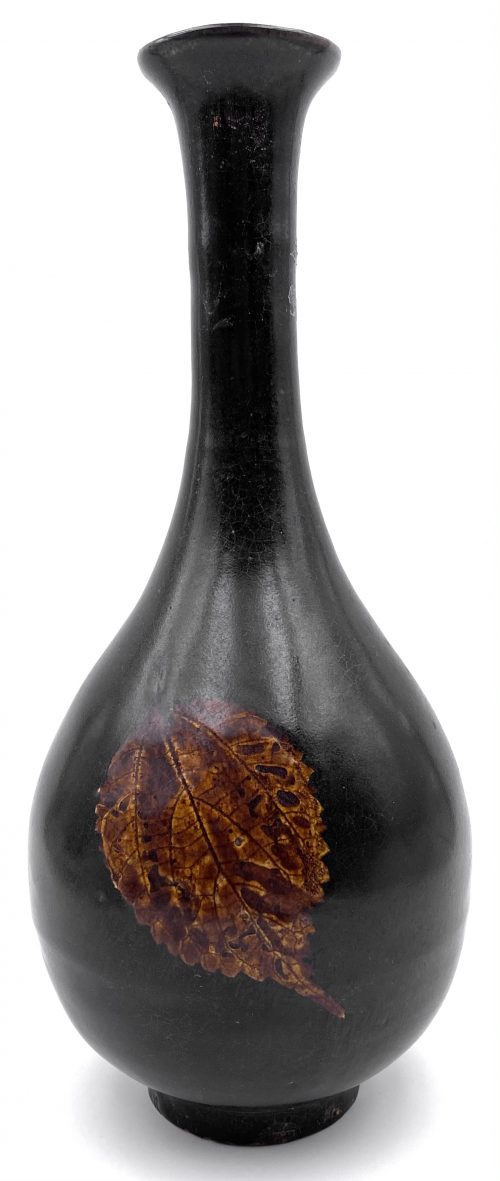 Jizhou black glaze bottle decorated with a leaf, placed on to the glaze before firing, and burnt away in the kiln to leave its pattern. Foot unglazed. China, the Song dynasty [宋朝] (960 – 1279). Height: 27.5 cm.
Jizhou black glaze bottle decorated with a leaf, placed on to the glaze before firing, and burnt away in the kiln to leave its pattern. Foot unglazed. China, the Song dynasty [宋朝] (960 – 1279). Height: 27.5 cm. -
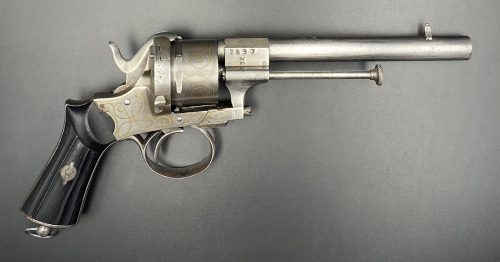 Serial number 8697, barrel 14.5 cm, calibre 9 mm Lefaucheux M-1858 double-action pin-fire revolver manufactured in the late 1860-s. Produced in France with no retailers marking but having French proofs on front of the cylinder and right side of barrel trunnion. The metal remains in the white with small gold wire inlays. Fluted 2 piece ebony grips. This pattern has been observed in civil war photographs and excavated from battlefields and camps in the United States. Dimensions: L: 25 cm; H: 13 cm; Barrel: 14.5 cm.
Serial number 8697, barrel 14.5 cm, calibre 9 mm Lefaucheux M-1858 double-action pin-fire revolver manufactured in the late 1860-s. Produced in France with no retailers marking but having French proofs on front of the cylinder and right side of barrel trunnion. The metal remains in the white with small gold wire inlays. Fluted 2 piece ebony grips. This pattern has been observed in civil war photographs and excavated from battlefields and camps in the United States. Dimensions: L: 25 cm; H: 13 cm; Barrel: 14.5 cm. -
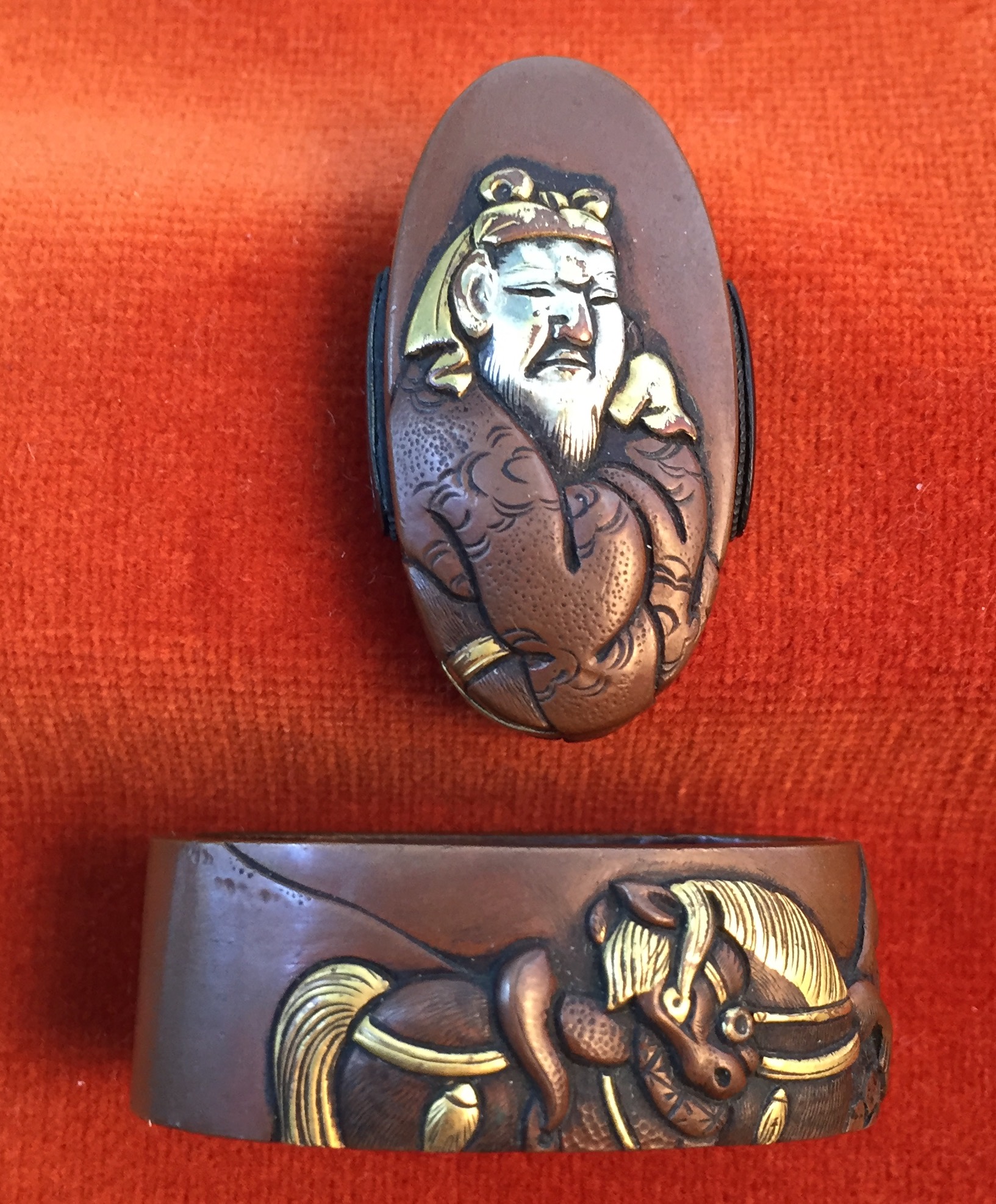 Fuchi: 38 x 22 x 14 mm. Kashira: 33 x 18 x 9 mm Techniques: Usu-shishiai-bori (薄肉合彫) – low-relief, zogan.
Fuchi: 38 x 22 x 14 mm. Kashira: 33 x 18 x 9 mm Techniques: Usu-shishiai-bori (薄肉合彫) – low-relief, zogan. -
 Iron tsuba of round form with design of triple diamond (matsukawa-bishi) in openwork (sukashi). Square rim. Ko-Tosho school. Nanbokucho period: Late 14th century (Oan/Eiwa era). Height: 92.3 mm. Width: 92.3 mm. Rim thickness: 2.5 mm. Center thickness: 3.0 mm. Provenance: Sasano Masayuki Collection, № 15: "Two small lozenges are attached to each end of a larger lozenge. Most Ko-tosho tsuba have inspirational designs, however this has a rather casual appearance, although it represents the unstable political situation at the time".
Iron tsuba of round form with design of triple diamond (matsukawa-bishi) in openwork (sukashi). Square rim. Ko-Tosho school. Nanbokucho period: Late 14th century (Oan/Eiwa era). Height: 92.3 mm. Width: 92.3 mm. Rim thickness: 2.5 mm. Center thickness: 3.0 mm. Provenance: Sasano Masayuki Collection, № 15: "Two small lozenges are attached to each end of a larger lozenge. Most Ko-tosho tsuba have inspirational designs, however this has a rather casual appearance, although it represents the unstable political situation at the time". -
 Iron tsuba of round form with design of rabbit (usagi) in openwork (sukashi) and inlaid with designs of plants and family crests (mon) in suemon-zōgan. A branch with lonely leaf, half chrysanthemum, and flying wild geese on the face represent autumnal connotations. The same motif is complemented by a clove (choji) on the reverse. The family crests (mon) include: interlocked rings (kanawa; wachigai), three encircled lines or stripes (hikiryo), bit or muzzle (kutsuwa - horse's harness element with possible christian symbolism), and encircled triangle (uroko, fish scale). Brass wire trim around the openwork elements and the seppa-dai, scalloped wire inlay around the hitsu-ana. Iron is dark, almost black. Brass or copper elements vary in shades of lighter and darker yellow with red-ish hue. Ōnin school. Late Muromachi period, 16th century. Height: 89.6 mm; Width: 89.3 mm; Thickness at seppa-dai: 3.0 mm. Weight: 129.7 g.
Iron tsuba of round form with design of rabbit (usagi) in openwork (sukashi) and inlaid with designs of plants and family crests (mon) in suemon-zōgan. A branch with lonely leaf, half chrysanthemum, and flying wild geese on the face represent autumnal connotations. The same motif is complemented by a clove (choji) on the reverse. The family crests (mon) include: interlocked rings (kanawa; wachigai), three encircled lines or stripes (hikiryo), bit or muzzle (kutsuwa - horse's harness element with possible christian symbolism), and encircled triangle (uroko, fish scale). Brass wire trim around the openwork elements and the seppa-dai, scalloped wire inlay around the hitsu-ana. Iron is dark, almost black. Brass or copper elements vary in shades of lighter and darker yellow with red-ish hue. Ōnin school. Late Muromachi period, 16th century. Height: 89.6 mm; Width: 89.3 mm; Thickness at seppa-dai: 3.0 mm. Weight: 129.7 g. -

Copper tsuba of oval form carved in kebori and katakiribori with Tekkai Sennin sitting under bamboo on the face and with a pine tree on the back. Ishime-ji treated surface.
Signed on the reverse: Jōi (乗 意).
Edo period (First half of 18th century). Dimensions: 69.6 x 66.5 x 4.5 mm Sugiura Jōi (杉 浦 乗 意) was a master of Nara School in Edo; he was a student of Toshinaga [M. Sesko, 'Genealogies', p. 32]. "Sugiura Jōi (1701-1761) made many fuchigashira and kozuka, tsuba are rather rare." [M. Sesko, The Japanese toso-kinko Schools].


